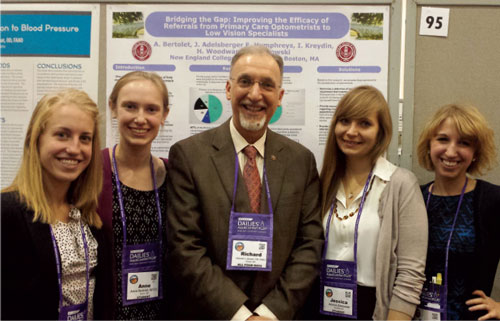 | |
|
Students from New England College of Optometry, along with faculty advisor Richard Jamara, OD, stand by their low vision research. |
How do you define low vision? The lack of a clear definition of this disorder may be discouraging referrals to low vision specialists, according to a poster presented at the recent American Academy of Optometry 2014 meeting by students from the New England College of Optometry.
“One of the major points our results suggest is that there is a discrepancy between what primary care optometrists and low vision specialists define as low vision,” says Anne Bertolet.
She and other optometry students—Emily Humphreys, Hannah Woodward, Jessica Zebrowski, Inna Kreydin and Jenna Adelsberger—focused on identifying patient barriers to low vision treatment. These include economic status, physical location relative to an office and a lack of access to relevant information.
Most of the low vision specialists they interviewed defined low vision as “any visual impairment that can hinder quality of life or daily functioning.”
But primary care optometrists were more varied in their definitions, with some using a functional definition and others using one of a number of best-corrected visual acuity-based definitions.
These differing opinions mean it’s likely some patients who could benefit from low vision services are not getting the referral they need, Ms. Bertolet explained. Thus, “developing a standardized definition would be advantageous to help normalize the referral and treatment processes.”

